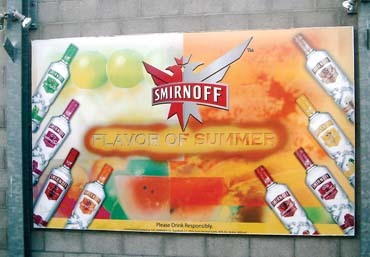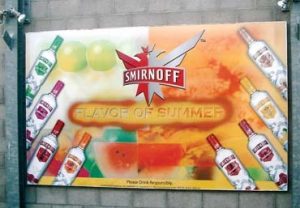Digital Printing
Shopping for the Perfect Inkjet Combination
Coatings and media must be carefully matched.
Published
18 years agoon

Who needs topcoated, inkjet vinyl these days? With the advent of low-cost, solvent printers that can print on most vinyls, sales of topcoated vinyl have declined, and some predict their obsolesence.
Think again. Just when the market assumes a product is doomed, someone develops an innovative, rejuvenating twist.
I’ll discuss topcoated-vinyl upgrades and how they work, and suggest how to select inkjet-printing components.
A delicate balance
Material selection would be much easier if every inkjet vinyl worked with every printer. But, life doesn’t work that way. Interrelated printing components, such as the printer, vinyl, ink, and clearcoat or overlaminate, create a very complex chemical mix. And, because the technology continually evolves, many long-term, real-time, test results aren’t available for all components.
In an ideal world, purchasing decisions would be a simple matter of price comparison. However, that also isn’t how it works. In fact, inkjet-vinyl selection is especially difficult, because photorealistic reproduction, color gamut and outdoor durability rely on the interrelationships of the printer, ink, vinyl and (when used) overlaminate. Any equation factor that changes can alter a delicate balance.
AdvertisementTop-coated inkjet vinyl
Your vinyl and printer must match. If you’re printing with a thermal-inkjet system that uses only waterbased inks, you need a vinyl with a special topcoating or receptor coating so the ink will adhere to vinyl. Without the coating, waterbased inks bead up on the film’s surface, just as water beads up on a newly waxed car.
Coatings can do more than bind an ink to the substrate. Some enhance the ink’s appearance by controlling its flow. Although the receptor coating absorbs the ink, it also needs to maintain the dot structure on the media. This prevents ink spreading, which destroys any print definition. If the dots bleed together, the printed image can appear fuzzy and darker than intended. Good dot integrity creates crisper images and intense, vibrant colors.
Some complex, topcoating systems comprise two layers. In this type of system, the ink passes through the top layer, and the basecoat absorbs it. The top layer acts as a barrier and protects the ink system from UV light, water, chemicals and abrasion. And, the coating must accept heavy ink saturation.
Some topcoated vinyls reportedly work with dye-based and pigmented inks. Prints produced by these ink types may look significantly different.
Pigmented inks comprise large molecules many times the size of dye molecules. Because of their size, pigmented inks struggle to penetrate a topcoat and tend to remain on the surface. Conversely, smaller dye molecules seep readily into the coating.
AdvertisementIn addition to making an ink adhere well to the vinyl substrate, topcoats also accelerate ink drying. Other coatings form a protective barrier between the ink and the vinyl that provides dye-based inks with some water resistance.
Although UV-inhibiting, topcoat additives provide some fade resistance, dye-based ink isn’t outdoor-durable. A printed image’s durability, however, largely depends on the ink, not the coating or vinyl. Although a coating provides limited ink protection, clearcoats or overlaminates may still be needed.
Chemistry differentiates topcoated, inkjet vinyls. Companies that specialize in coatings for different types of plastic films have developed hundreds of varieties. Each coating caters to a specific printing technology and, therefore, has unique, physical properties.
When evaluating products, remember that all topcoated vinyls aren’t created equal. Chemistry, coating thickness and film consistency affect print quality, durability and print-production waste. A great price means nothing if a shop loses 10% of its work.
Some new inkjet films’ topcoats must be cured using an infrared heater. They’re reportedly compatible with dye-based and pigmented inks. When these materials are heated, topcoating encapsulates the colorant, and both fuse to the vinyl through a polymerization process.
The process’ high heat won’t distort the printed image. Encapsulating the ink inside the film protects the printed image from moisture, chemicals and abrasion. Clearcoating and overlaminates aren’t needed, but the system requires some additional equipment.
AdvertisementTotal system approach
Some vinyl companies use a total-system approach that integrates components in a warranted graphics solution that combines the printer, inkjet vinyl, ink, overlaminates, surface-protection masking and printing profiles. For example, 3M Industrial Adhesives & Tapes Div. has formed alliances with printer manufacturers Roland DGA Corporation, Hewlett-Packard and EFI.
Selecting the pre-package system approach eliminates most of your guesswork and also minimizes printing catastrophes. The systems approach is clearly the safest choice, because manufacturers have done the costly and time-consuming lab and field testing. In this package deal, the signmaker gets peace of mind should a problem occur. However, the years of R&D and the warranty security come with a pricetag.
Mix and match
Although some OEMs warn of the potential component-substitution problems, most signmakers mix and match when selecting consumables. If that’s your approach, be sure to "test, don’t guess." Testing and evaluating media, inks, clearcoats and overlaminates don’t need to be complicated or require expensive lab equipment. But, it will take time.
Keep your testing simple. The most reliable durability test entails simply placing a printed sample in sunlight to see how long it lasts without fading. The results of printing different inks on the same vinyl, or one ink on different vinyls, may vary greatly. To most reliably evaluate image and color reproduction, print on different materials, and select the best.
Because vinyl stretches, the topcoating must stretch with it. After printing and clearcoating a test sample, pull and see what happens to the printed image. If everything works, the image will stretch too. If it doesn’t, the ink and topcoat will crack.
For sign applications, fade resistance is also critical. The best test of outdoor durability is outdoor exposure. You’ll know a graphics system will last two years in the sun only if you test these exact conditions and times. This is much more reliable than accelerated weathering of a test sample in a weatherometer.
Outdoor graphics, especially vehicle graphics, endure such demanding conditions as moisture, chemical spillage and ink adhesion. Ink adherence to vinyl is critical for these applications.
Because solvent-based inks incorporate different solvents, they won’t adhere equally well to uncoated vinyl. So, test ink-to-vinyl adhesion using two screenprinting tests that gauge ink adhesion. The first is called the thumbnail test — just rub your thumbnail over the test print and see if ink scratches off.
The second is the cross-hatch test. Lightly score the ink surface with an X-acto® knife. Then, apply transparent tape to the ink and pull it off perpendicular to the film’s surface.
Consider these factors when evaluating inkjet vinyl:
• Contrast the color’s richness between prints.
• Check for fuzzy edges or detail loss.
• Note how long it takes for a print to dry.
• Consider the film’s handling characteristics during vinyl application.
• Determine if the release liner impacts print processing.
Overlaminates and clearcoats
Any sign that’s subjected to a demanding environment should be clearcoated or protected with an overlaminate. That covers most outdoor applications. When making product selections, pair calendered and cast vinyls to matching overlaminates.
Although inkjet inks’ fade resistance has improved, any printed image needs protection from abrasion and cleaning chemicals. Vinyl overlaminates are available with different finishes, such as matte, luster and satin, that complement the print’s appearance.
Overlaminates also provide vinyl graphics with added stiffness, which can ease film handling during graphics installation. However, the print still needs surface-protection masking. With or without an overlaminate, premasking a print can prevent vinyl from stretching during film application and repositioning. The mask also protects the print surface from squeegee scratches.
High-tack application tape is usually too aggressive for digital prints. During one application, high-tack tape pulled the overlaminate, ink and the topcoat off the vinyl substrate as I removed the tape. Although much of the problem could be attributed to a topcoat failure, we used the wrong tape. For digital prints, ask your distributor for an ultra-low-tack, surface-protection masking.
Liquid laminates, which are cost-effective alternatives to overlaminates, may be either spraypainted or applied with a roller. Be sure to use the right one for your ink system. Some solvent-based clearcoats are designed to work with waterbased inks, whereas waterbased clearcoats match solvent-based inks. For any product questions, ask your distributor.
Before production, test all components to ensure the vinyl, ink and clearcoat are compatible. Testing can simply entail coating a print and checking to see if any adverse reaction occurs, or verifying that you achieve good ink-to-vinyl adhesion.
Conclusion
Many people choose inkjet media during printer evaluation. For equipment and consumables consideration, your sign-supply distributor should provide the necessary technical information.
Vinyl and printer manufacturers can also provide good advice for selecting appropriate products.
Once you’ve determined a successful materials combination, stay with it.
SPONSORED VIDEO
Introducing the Sign Industry Podcast
The Sign Industry Podcast is a platform for every sign person out there — from the old-timers who bent neon and hand-lettered boats to those venturing into new technologies — we want to get their stories out for everyone to hear. Come join us and listen to stories, learn tricks or techniques, and get insights of what’s to come. We are the world’s second oldest profession. The folks who started the world’s oldest profession needed a sign.
You may like
Advertisement
Subscribe

Magazine
Get the most important news
and business ideas from Signsofthetimes Magazine.
Advertisement
Most Popular
-

 Tip Sheet4 days ago
Tip Sheet4 days agoAlways Brand Yourself and Wear Fewer Hats — Two of April’s Sign Tips
-

 Business Management2 weeks ago
Business Management2 weeks agoWhen Should Sign Companies Hire Salespeople or Fire Customers?
-

 Women in Signs2 weeks ago
Women in Signs2 weeks ago2024 Women in Signs Award Winners Excel in Diverse Roles
-

 Real Deal5 days ago
Real Deal5 days agoA Woman Sign Company Owner Confronts a Sexist Wholesaler
-

 Benchmarks20 hours ago
Benchmarks20 hours ago6 Sports Venue Signs Deserving a Standing Ovation
-

 Editor's Note1 week ago
Editor's Note1 week agoWhy We Still Need the Women in Signs Award
-

 Line Time2 weeks ago
Line Time2 weeks agoOne Less Thing to Do for Sign Customers
-

 Product Buying + Technology1 week ago
Product Buying + Technology1 week agoADA Signs and More Uses for Engraving Machines











